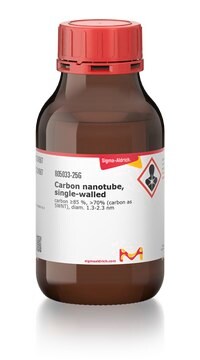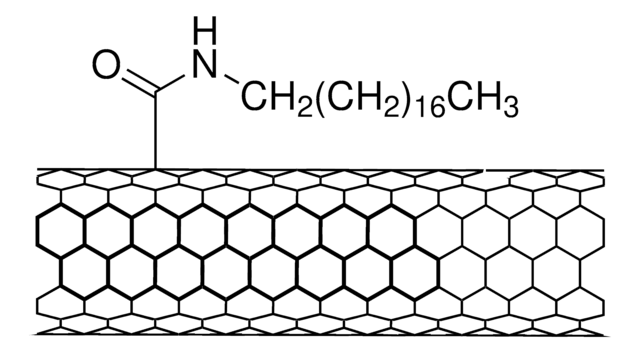724777
Carbon nanotube, single-walled
≥90% carbon basis (≥80% as carbon nanotubes), 1-2 nm diameter, avg. no. of layers, 1
Synonym(s):
CNT, SWCNT, SWNT, Single wall carbon nanotube
About This Item
Recommended Products
description
G/D Ratio: ≥15 (Raman 633 nm)
Median length: 1 μm
Quality Level
Assay
≥90% carbon basis (≥80% as carbon nanotubes)
form
powder (freeze-dried)
feature
avg. no. of layers 1
manufacturer/tradename
Signis® CG200
surface area
≥700 m2/g
impurities
≤5 wt. % Moisture
diameter
1-2 nm
mp
3652-3697 °C (lit.)
density
1.7-1.9 g/cm3 at 25 °C (lit.)
bulk density
0.1 g/cm3
SMILES string
[C]
Looking for similar products? Visit Product Comparison Guide
Related Categories
General description
Application
Preparation Note
Legal Information
Storage Class Code
11 - Combustible Solids
WGK
WGK 3
Flash Point(F)
Not applicable
Flash Point(C)
Not applicable
Choose from one of the most recent versions:
Already Own This Product?
Find documentation for the products that you have recently purchased in the Document Library.
Customers Also Viewed
pandemic influenza A H1N1 virus infectivity of
lung epithelial cells
Articles
Manufacturing, Characterization and Use of Single Walled Carbon Nanotubes
The CoMoCAT® method of single-walled carbon nanotube (SWNT) synthesis yields high purity SWNTs with specific chiralities and narrow distributions of tube diameters.
Composite materials that traditionally incorporate micron scale reinforcements in a bulk matrix offer opportunities to tailor material properties such as hardness, tensile strength, ductility, density, thermal and electrical conductivity, and wear resistance.
Carbon nanomaterials (CNMs), such as single-walled carbon nanotubes (SWCNTs), multi-walled carbon nanotubes (MWCNTs), and graphene (Figure 1), have diverse commercial applications including lighter and stronger composite materials, improved energy storage devices, more sensitive sensors, and smaller transistors.
Protocols
Single-Walled Carbon Nanotubes: Exfoliation and Debundling Procedure
Single-Walled Carbon Nanotubes synthesized by the Super-Growth Method & their properties & applications, including dispersing SGCNTs, SGCNT-polymer composites & SGCNT-metal composites are discussed.
Our team of scientists has experience in all areas of research including Life Science, Material Science, Chemical Synthesis, Chromatography, Analytical and many others.
Contact Technical Service





